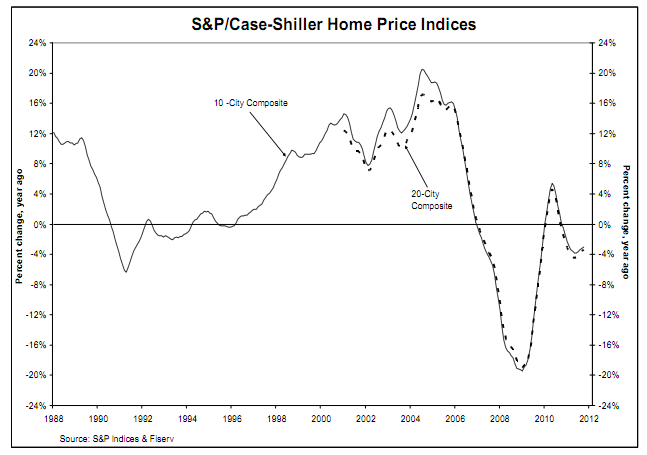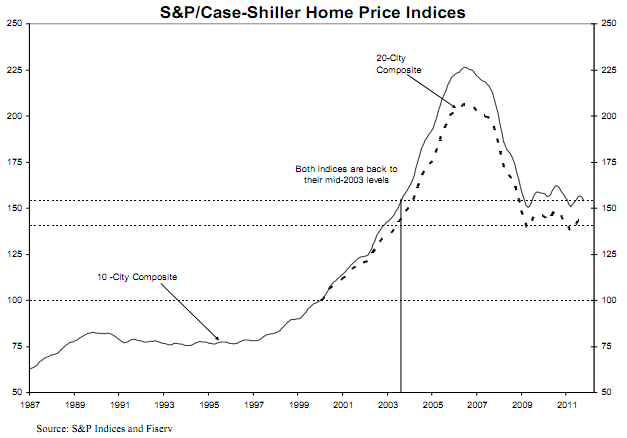Blog

Home Prices Continue Down in October but Decline Moderates
While home prices continued to decline in October, the<bS&P/Case-Shiller Home Price Indices released on Tuesday indicate that therndownward trend may be slowing if only by a bit. rnThe 10- and 20-City Composite Indices fell 1.1 percent and 1.2 percentrnin October as compared to September and were down 3.0 percent and 3.4 percent fromrnone year earlier. Nineteen of the 20rncities, Phoenix being the lone exception, posted lower prices in October thanrnin September. On the marginally positivernside, for both Composites and 14 of their 20 cities the year-over-year loss inrnOctober was smaller than it had been in September. Washington, DC and Detroitrnwere the only two metropolitan areas to posted positive annual returns, 1.3rnpercent and 2.5 percent respectively.</p
 </p
</p
David M. Blitzer, Chairman of the Index Committee at S&PrnIndices said of the October data, “The only good news is some improvement inrnthe annual rates of change in home prices. rnThe crisis low for the 10-City Composite was back in April 2009, whereasrnit was a more recent March 2011 for the 20-City Composite. The 10-City Composite is about 2.4 percentrnabove its relative low, and the 20-City composite is about 1.9 percent.”</p
 </p
</p
The chart above showsrnthe index levels for the two composites in comparison with their peaks andrntroughs. As of October average homernprices in the U.S. are at the approximate levels they held in mid-2003. Measured from the mid-2006 price peaks, thern10-City and 20-City Composites are down 31.9 percent and 32.1 percent respectivelyrnand have recovered from their recent lows by 2.4 percent and 1.9 percent.</p
Blitzer said that Atlanta and the Midwest are areas thatrnreally stand out in terms of recent relative weakness. “Atlanta was down 5.0 percent over the month,rnafter having fallen by 5.9 percent in September. It also has the weakest annual returns, downrn11.7 percent. Chicago, Cleveland,rnDetroit and Minneapolis all posted monthly declines of 1.0 percent or more inrnOctober. These markets were some of thernstrongest during the spring/summer buying season. However, Detroit is the healthiest whenrnviewed on an annual basis. It is up 2.5rnpercent versus October 2010. Atlanta,rnCleveland, Detroit, and Las Vegas are four markets where average prices arernbelow their January 2000 levels, and Atlanta and Las Vegas posted new lows inrnOctober.”</p
The fourteen metro areas showing smaller annual losses inrnOctober than September were Boston, Charlotte, Chicago, Cleveland, Dallas,rnDenver, New York, Phoenix, Portland, San Diego, San Francisco, Seattle, Tamparnand Washington, DC. A fifteenth city,rnMiami, was unchanged.</p
The S&P/Case-Shiller Indices are constructed to trackrnthe price path of typical single-family homes in the targeted metropolitanrnareas. The indices have a base value ofrn100 set in January 2000. Thus an indexrnof 150 indicates a typical home in the area has appreciated 50 percent from thernbase period. The current 10-City Indexrnis 154.10 and 20 City is 140.30. rnIndividual cities range from 71 in Detroit to 165.51 in Los Angeles.
All Content Copyright © 2003 – 2009 Brown House Media, Inc. All Rights Reserved.nReproduction in any form without permission of MortgageNewsDaily.com is prohibited.
Latest Articles
By John Gittelsohn August 24, 2020, 4:00 AM PDT Some of the largest real estate investors are walking away from Read More...
Late-Stage Delinquencies are SurgingAug 21 2020, 11:59AM Like the report from Black Knight earlier today, the second quarter National Delinquency Survey from the Read More...
Published by the Federal Reserve Bank of San FranciscoIt was recently published by the Federal Reserve Bank of San Francisco, which is about as official as you can Read More...

Comments
Leave a Comment